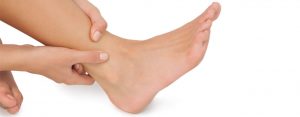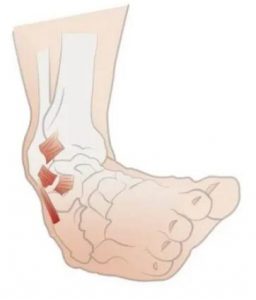The ankle joint plays an important role in human mechanics. The ankle joint supports a person’s entire body weight and is therefore prone to injury. A strain or sprain of the ankle joint can lead to strains of the tendons and muscles around the joints, torn ligaments, and even fractures.
I. So, what kind of sprain or strain must be treated in the hospital:
1. You heard a “pop” when you were injured
2. Severe pain, unable to stand on both feet normally.
3. Lightly pressing the injured joint or the area next to it is already very painful.
4. The injured ankle joint is swollen obviously.
5. The injured joint cannot move.
6. Can’t walk more than four steps without obvious pain.
7. Feeling numb in the injured area.
8. Red spots or red streaks spreading from the injured area.
9. The injured part has been injured before
10. The injured foot has pain, swelling, or redness.
If the injury is mild, you can handle it yourself, but you should closely observe the changes in the pain and swelling of the ankle joint. Treatment of ankle sprains: Protect and rest, apply ice for 24-48 hours, use elastic bandages to fix it if you need to move, and do everything possible to raise the affected limb.

II. What should I do if I often get rid of my ankle? As long as you raise it well, will you not be in trouble in the future?
This is not the case. We often find that if one ankle is sprained, it becomes your “soft underbelly”, and the injured ankle will be strained and strained repeatedly. This is because the repair of muscles, tendons, and ligaments is scar healing (same as scars on the skin), and the lack of elasticity of the tissues affects the flexibility of the ankle joint. In addition, the motion receptors in the ankle joint are damaged when sprained, which makes the affected ankle joint feel less sense of its position changes during exercise, which affects the nervous system’s control of the ankle joint motion. Therefore, scientific rehabilitation training should be carried out after ankle joint injury.
III. How to train after the foot? When will there be any training?
1. Once the pain is controlled and the swelling is not getting worse, try to continue the following activities
①Towel stretch:
Sitting on a hard surface, your injured leg stretches out in front of you. Use a towel around the soles of your feet and pull the towel toward your body, keeping your knee joints straight. Hold this position for 15 to 30 seconds, then relax. Repeat 3 times.
②The range of motion of ankle joint:
Sit or lie down with your legs straight and your knees pointing towards the ceiling. Point your injured toe to your nose and then away from your body. Point your toe toward your other foot and move in the opposite direction. Then draw circles with your feet. Repeat 10 times in each direction. Doing this action should ensure that the pain in the ankle joint is not aggravated.

2. If you can complete the normal standing on both feet, the pain will not worsen
①Standing calf stretch:
Standing on the wall, hands on the wall, almost eye level. Put your heels on the floor and let the injured leg fall back. Keep the other leg forward and bend the knee. Turn your back foot slightly inward (inner horoscope). Slowly lean towards the wall until you feel a stretch in the back of your calf. Keep stretching for 15 to 30 seconds. Return to the starting position. Repeat 3 times. Do this exercise several times each day.
②Standing soleus muscle stretch:
Stand in front of the wall with your hands on the wall and chest height. Put your heels on the floor and let the injured leg fall back. Keep the other leg forward and bend the knee. Turn your back foot slightly inward (inner horoscope). Bend your back knee slightly and lean gently towards the wall until you are feeling the calf of your injured leg stretched. Keep stretching for 15 to 30 seconds. Return to the starting position. Repeat 3 times.
③Resistance to ankle flexion:
Sitting, your injured leg stretched ahead of you. Wrap the bungee cord around your feet. Hold both ends of the bungee cord with both hands. Slowly do flexion and extension activities, returning to the starting position each time. Do 2 sets, 15 reps in each set.
④ Resistance to ankle inversion and eversion:
Sit with your legs stretched out in front of you, and your feet should be about the width of your shoulders apart. Tie one end of the elastic rope into a loop. Pass the foot of the injured leg through the loop, slowly turn the ankle joint inward and outward, and then return to the starting position. Do 2 sets, 15 reps in each set.

3. If you can stand on your feet without pain
①The heel is raised:
Stand behind a chair or counter together with your feet flat on the ground. Use a chair or counter as a support, stand on your toes, and hold for 5 seconds. Then loosen the back of the chair and slowly lower yourself. Can gradually transition to one foot to complete this action. Do 2 sets, 15 reps in each set, and rest for 30 seconds between the two.
②Side-up training:
Stand on a support 8 to 13 cm high with your injured leg and place your other foot flat on the floor. First transfer your weight to the injured leg, gradually straighten the injured leg, and slowly lower the uninjured leg back to the ground, back to the starting position. Do two groups of 15 people.
③Single-leg balance exercises:
Stand next to a chair farther from the chair, bend your knees slightly, try to lift your healthy leg, grab the toes of the affected foot, straighten your knees, bend your waist, and stretch your hands as far as possible forward and sideways. Repeat 15 times. Increasing the difficulty can be done by stepping on a soft cushion under the affected foot.
④Side leg lift:
Lying on the contralateral side, tighten the muscles on the injured leg, lift the leg 20 to 25 cm from the other leg, keep the leg straight during this process, and then slowly lower it. Repeat 15 times.

This group of training can be continued for 2-3 months to restore and improve the movement sensation of the affected limb, to achieve the purpose of preventing repeated ankle joint injuries.
In rehabilitation training, we must proceed step by step and avoid radicalism. If the pain and swelling get worse, consult a doctor promptly.
Hot blogs:
The Easiest Custom Insoles: Heat Moldable Insoles
Custom insoles, also known as orthotic insoles, are designed to provide personalized support and comfort for individuals with various foot conditions. In [...]
Children’s Insole Size Conversion Chart
The standard sizes for shoe insoles may vary from country to country, making it a headache to choose the right insole for [...]
Do custom orthotics need to be made by a doctor personally?
Custom orthotics do not necessarily need to be made by a doctor personally. While doctors, specifically podiatrists or orthopedic specialists, are often [...]
Do NBA players use custom insoles?
Custom insoles are not only helpful for people with foot health issues, but they also play a significant role in targeting the [...]
